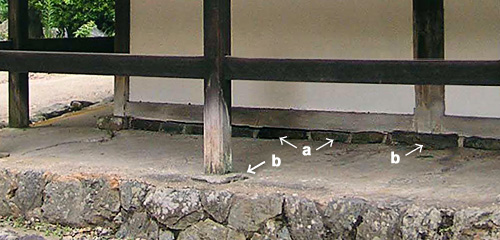The footing
or foundation of a building. A generic term for any substructure that bears
the weight of a superstructure. After preparing and leveling the ground,
the location of the pillars and walls are marked out. Circular holes are
made to receive the footing stones which support the pillars. Trenches are
dug for the stone wall foundation. If the soil is weak, a deep hole is dug
for the under-pillars. Some foundation stones are extra long large stones
called candle stones rousoku-ishi 蝋燭石, kiso-ishi 基礎石 or
*soseki 礎石 and are
set vertically in the stone-fitted hole base. Plinth stones *nuno-ishi
布石 and base stones *ne-ishi
根石, are also used if needed. The soil around the foundation stones is then
packed to ground level. When plinth stones or base stones are not used,
a non-penetrating sill *jifuku
nageshi 地覆長押, is laid directly across the top of the deeply embedded
pillar support stone and along the foundation stones of the walls. The foundation
includes a bed of smaller stones on which fill-in gravel *hazama-ishi
狭間石 is used to fill the interstices between the bedded stones and the non-penetrating
sill.
The term kiso is also used for the bases of stone lanterns,
ishidourou 石灯籠. See *tourou 灯籠, *ukeza 受座. |



